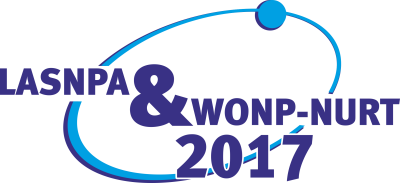Speaker
Description
During the last 6 year, the infrastructure related with Experimental Nuclear Physics at the Physics Institute, UNAM, has been benefited with an unprecedented injection of resources: four new beam lines were mounted at the CN-Accelerator Van der Graaff of 5.5 MV, which originally had just one. Moreover, a modern Tandetron AMS system of 1 MV was acquired in order to establish this kind of technique for the first time at Mexico. This AMS system is nowadays a National Laboratory called LEMA.
In one of the lines of the Van der Graaff Accelerator was built a permanent windowless Supersonic Gas target (SUGAR), which is been completed with a neutron wall composed of 16 scintillator crystals (MONDE). With this combination will be possible to measure coincidences between charge particles and neutrons and/or gammas.
To complete the AMS system, and additional beam line will be coupled to the accelerator in order to extract intense and pure stable beams at low energy. In addition, the current radioactive beams used for AMS purposes, will be able to be used with an acceptable intensity in order to develop experiments related with the scattering and resonances of $^{13,14}$C and $^{26}$Al, using light targets.
In this work are presented some of the characteristics of all these new systems: the first data related with the commissioning of the Supersonic Gas Target, where the $^{14}$N(d,$\alpha$)$^{12}$C was studied, achieving a good resolution for the alpha resonances and proving the good qualities of the entire system; besides, is described the first approximation for the measurements of cross sections for the $^{28}$Si(d,$\alpha$)$^{26}$Al and $^{25}$Mg(p,$\gamma$)$^{26}$Al reactions at low energies, where are used the two accelerators that were mentioned before, the CN-Accelerator to produce the reaction, and the AMS system to measure the concentration of $^{26}$Al produced after the irradiation. These $^{26}$Al concentrations are directly related with cross sections of a particular reaction energy, whose values are currently interesting for Astrophysics parameters.
This research is been partially supported by PAPIIT-DGAPA-UNAM-Project: IA101616.
- C. Solís, et al. Nucl. Inst. Meth. Phys. B 331 (2014) 233–237.
- F. Favela, et al. Phys. Rev. ST-AB, Vol.18, Pag.1-10. (2015).
- P. Santa Rita, et al. J. of Phys. Conf. Ser, Vol.730, Pag.1-7 (2016).
- V. Araujo-Escalona, et al. J. of Phys. Conf. Ser,Vol.730, Pag.1-7 (2016).
- A. Arazi, et al. Phys. Rev. C. 74, 025802 (2006).

